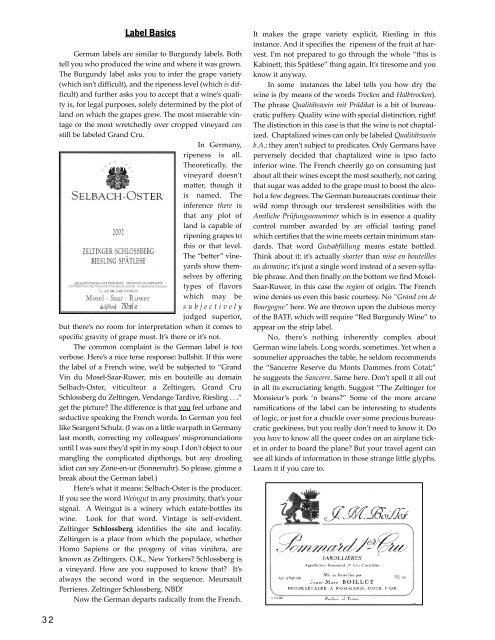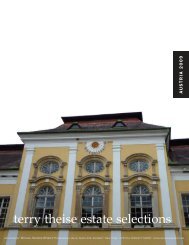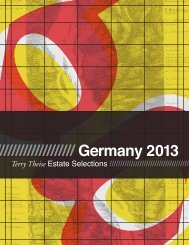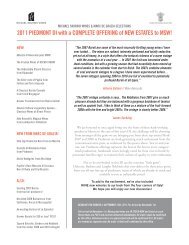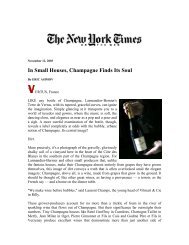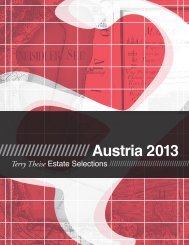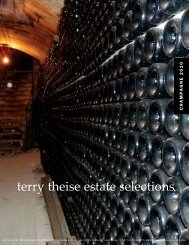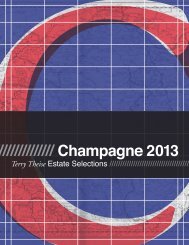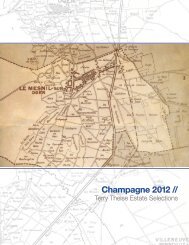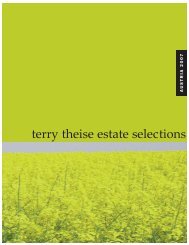German Catalog 2006 USE THIS ONE.qxp - Michael Skurnik Wines
German Catalog 2006 USE THIS ONE.qxp - Michael Skurnik Wines
German Catalog 2006 USE THIS ONE.qxp - Michael Skurnik Wines
Create successful ePaper yourself
Turn your PDF publications into a flip-book with our unique Google optimized e-Paper software.
32<br />
Label Basics<br />
<strong>German</strong> labels are similar to Burgundy labels. Both<br />
tell you who produced the wine and where it was grown.<br />
The Burgundy label asks you to infer the grape variety<br />
(which isn’t difficult), and the ripeness level (which is difficult)<br />
and further asks you to accept that a wine’s quality<br />
is, for legal purposes, solely determined by the plot of<br />
land on which the grapes grew. The most miserable vintage<br />
or the most wretchedly over cropped vineyard can<br />
still be labeled Grand Cru.<br />
In <strong>German</strong>y,<br />
ripeness is all.<br />
Theoretically, the<br />
vineyard doesn’t<br />
matter, though it<br />
is named. The<br />
inference there is<br />
that any plot of<br />
land is capable of<br />
ripening grapes to<br />
this or that level.<br />
The “better” vineyards<br />
show themselves<br />
by offering<br />
types of flavors<br />
which may be<br />
subjectively<br />
judged superior,<br />
but there’s no room for interpretation when it comes to<br />
specific gravity of grape must. It’s there or it’s not.<br />
The common complaint is the <strong>German</strong> label is too<br />
verbose. Here’s a nice terse response: bullshit. If this were<br />
the label of a French wine, we’d be subjected to “Grand<br />
Vin du Mosel-Saar-Ruwer, mis en bouteille au domain<br />
Selbach-Oster, viticulteur a Zeltingen, Grand Cru<br />
Schlossberg du Zeltingen, Vendange Tardive, Riesling . . .”<br />
get the picture? The difference is that you feel urbane and<br />
seductive speaking the French words. In <strong>German</strong> you feel<br />
like Seargent Schulz. (I was on a little warpath in <strong>German</strong>y<br />
last month, correcting my colleagues’ mispronunciations<br />
until I was sure they’d spit in my soup. I don’t object to our<br />
mangling the complicated dipthongs, but any drooling<br />
idiot can say Zone-en-ur (Sonnenuhr). So please, gimme a<br />
break about the <strong>German</strong> label.)<br />
Here’s what it means: Selbach-Oster is the producer.<br />
If you see the word Weingut in any proximity, that’s your<br />
signal. A Weingut is a winery which estate-bottles its<br />
wine. Look for that word. Vintage is self-evident.<br />
Zeltinger Schlossberg identifies the site and locality.<br />
Zeltingen is a place from which the populace, whether<br />
Homo Sapiens or the progeny of vitas vinifera, are<br />
known as Zeltingers. O.K., New Yorkers? Schlossberg is<br />
a vineyard. How are you supposed to know that? It’s<br />
always the second word in the sequence. Meursault<br />
Perrieres. Zeltinger Schlossberg. NBD!<br />
Now the <strong>German</strong> departs radically from the French.<br />
It makes the grape variety explicit, Riesling in this<br />
instance. And it specifies the ripeness of the fruit at harvest.<br />
I’m not prepared to go through the whole “this is<br />
Kabinett, this Spätlese” thing again. It’s tiresome and you<br />
know it anyway.<br />
In some instances the label tells you how dry the<br />
wine is (by means of the words Trocken and Halbtrocken).<br />
The phrase Qualitätswein mit Prädikat is a bit of bureaucratic<br />
puffery. Quality wine with special distinction, right!<br />
The distinction in this case is that the wine is not chaptalized.<br />
Chaptalized wines can only be labeled Qualitätswein<br />
b.A.; they aren’t subject to predicates. Only <strong>German</strong>s have<br />
perversely decided that chaptalized wine is ipso facto<br />
inferior wine. The French cheerily go on consuming just<br />
about all their wines except the most southerly, not caring<br />
that sugar was added to the grape must to boost the alcohol<br />
a few degrees. The <strong>German</strong> bureaucrats continue their<br />
wild romp through our tenderest sensibilities with the<br />
Amtliche Prüfungsunummer which is in essence a quality<br />
control number awarded by an official tasting panel<br />
which certifies that the wine meets certain minimum standards.<br />
That word Gutsabfüllung means estate bottled.<br />
Think about it: it’s actually shorter than mise en bouteilles<br />
au domaine; it’s just a single word instead of a seven-syllable<br />
phrase. And then finally on the bottom we find Mosel-<br />
Saar-Ruwer, in this case the region of origin. The French<br />
wine denies us even this basic courtesy. No “Grand vin de<br />
Bourgogne” here. We are thrown upon the dubious mercy<br />
of the BATF, which will require “Red Burgundy Wine” to<br />
appear on the strip label.<br />
No, there’s nothing inherently complex about<br />
<strong>German</strong> wine labels. Long words, sometimes. Yet when a<br />
sommelier approaches the table, he seldom recommends<br />
the “Sancerre Reserve du Monts Dammes from Cotat;”<br />
he suggests the Sancerre. Same here. Don’t spell it all out<br />
in all its excruciating length. Suggest “The Zeltinger for<br />
Monsieur’s pork ‘n beans?” Some of the more arcane<br />
ramifications of the label can be interesting to students<br />
of logic, or just for a chuckle over some precious bureaucratic<br />
geekiness, but you really don’t need to know it. Do<br />
you have to know all the queer codes on an airplane ticket<br />
in order to board the plane? But your travel agent can<br />
see all kinds of information in those strange little glyphs.<br />
Learn it if you care to.


